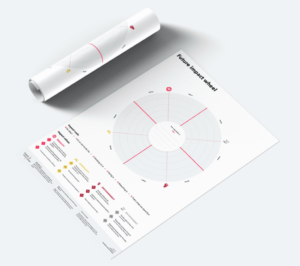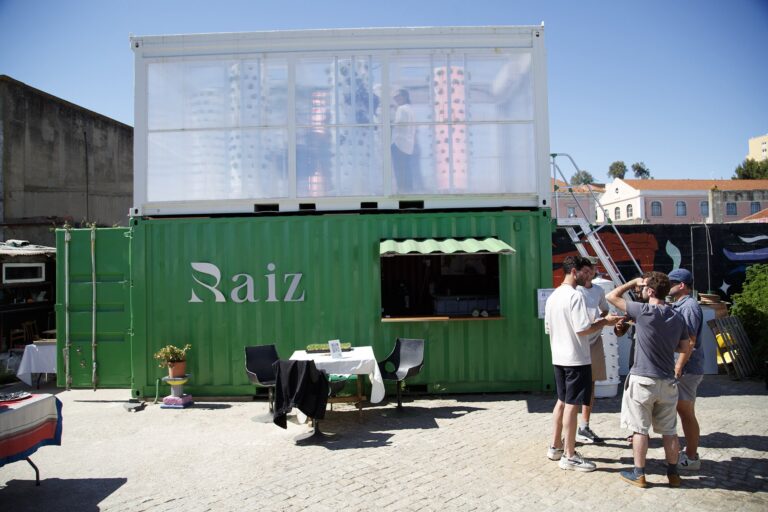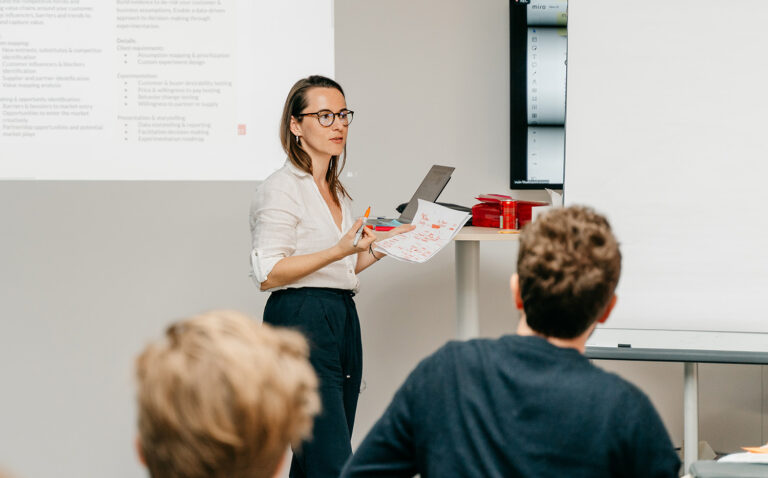Our innovation consultants co-create the innovation strategies of some of the world’s largest corporates alongside their executives. As business designers and challengers, we help future-proof their businesses by setting them up for success. But as future builders and facilitators, there’s an urgent need for us to encourage our clients to innovate not only for profitability and growth but also with a clear focus on building a better future where innovations have a positive impact. This must involve empowering collaboration, protecting the environment, promoting equality, and building flourishing communities.
Doing so will enable our clients’ businesses to continue providing value going forward. It is this innovation purpose (designing businesses with consideration of the entire ecosystem at play) that will truly enable us to future-proof corporations.
Why we need to go beyond customer-centricity.
Clients engage us when they realize the old way of working inside-out no longer serves their competitive advantage in the market. Thus, we’re brought in to build a bridge between the project team and their end-users and customers through a human-centered design methodology. By better understanding customer habits, needs, and aspirations, we’re able to create solutions that add more value.
As corporate innovators, we often limit our mission to serving the needs of end-users, customers, or internal key stakeholders. We rarely ask ourselves how the process of getting to this new solution is affecting the environment, nor how it’s impacting society at large. Those big questions are often overlooked not only for their complexity but also because addressing them doesn’t result in an immediate return on investment.
However, we can no longer afford to value today’s successes through short-term indicators when the wellbeing of our planet and the health of future generations is at stake. We need to think more systematically. To do so, we need to measure how the businesses and projects that we co-create serve (or fail to serve) our society and our environment.
It's time to reframe the innovation sweet spot.
We believe that all organizations, independently from their mission, can and should play a role in investing in future-centered innovation. Corporates are uniquely positioned to do so, as they have the financial capacity, speed, and global influence to be a driving force.
When judging social responsibility, we need to acknowledge the difference between corporations that simply participate in philanthropy, versus those that are driven by a clear mission to innovate for good and lead by example. Of course, we don’t want to discourage corporate giving which is imperative for the survival of many incredibly impactful NGOs. But rather to encourage you to consider how your organization can do good with the products and services that you already create and sell.
Many CEOs realize that activating a purpose in their company would actually have a positive impact on their performance and reputation (and consequently, their profit), but they lack the tools to measure and demonstrate the potential success of their future-proofing efforts.
When we think of the strategy behind innovation, we often refer to the innovation sweet spot framework that helps innovators consider desirability, viability, and feasibility.
The traditional innovation sweet spot does help us consider innovation with a human-centered mindset, but it does not encourage us to think about the impact innovations have on the future. Therefore, we propose adding a fourth layer to the innovation sweet-spot framework to make innovators consider integrity, too.
We’ve already introduced our re-envisioned future-centered innovation sweet spot in our work with clients. In doing so, we aimed to test whether it would indeed encourage them to think about the integrity of their innovation projects.
Does the revised sweet spot work?
From the outset, our updated innovation sweet spot triggered many fruitful discussions among the innovators who tried it. These are the key outcomes:
- Simply by adding this fourth layer of integrity to the innovation sweet spot, innovators were reminded and motivated to take the broader impact of their ideas into account. In at least three of the six teams tested, the future-centered innovation sweet spot clearly impacted the way they approached their concepts.
- Employees said they would like to approach innovation with a more holistic mindset, but didn’t feel it would fit within their company’s existing innovation strategy. This led to a major debate about innovation culture. Is it up to them, the employees, to make those changes bottom-up, or should they be empowered from top-down?
Who better to provide the solution than us? As both business designers and innovation consultants, we are uniquely placed to tackle the problem. We’re involved in both co-creating their innovation strategy, and influencing their innovation culture through our work enhancing employees’ innovation capabilities.
How we're enabling you to measure social impact.
This realization triggered us to design a tool to help you, the strategist, review your corporation not just according to the abstract concept of integrity, but by its actions. Doing so will enable you to determine whether you’re developing an innovation strategy that is indeed socially responsible, while also encouraging you to pinpoint the exact areas in which your company can improve.
We call it our Future Impact Wheel. We’ve tested our own company with it, along with some of the organizations we work with, but it’s still an MVP at this stage. We aim to improve it with your feedback.
This tool can be used by executives, but we would also like to see whether employees find success with it. We propose that employees use it to evaluate the organization and challenge not only each other but also their managers by highlighting areas that need to be improved.
The Future Impact Wheel also comes with a set of inspirational analogy cards around ‘star companies’ that score remarkably well on one or more of these impact values (disclaimer: these are still a work in progress; if we should include your company, please let us know). For these, we are considering two different formats: Either a complete analogy card about one specific company or condensing the information into brainstorm cards that ask triggering “what if” questions (similar to these brainstorm cards that we use during our ideation sessions).
Will the Future Impact Wheel be useful as a diagnostic tool only? Can it lead companies in the right direction? Help us find out. Download the tool below, evaluate your company, and let us know your findings in the form at the bottom of the download page.

Find out whether your innovations will contribute to a better future with our new tool.


